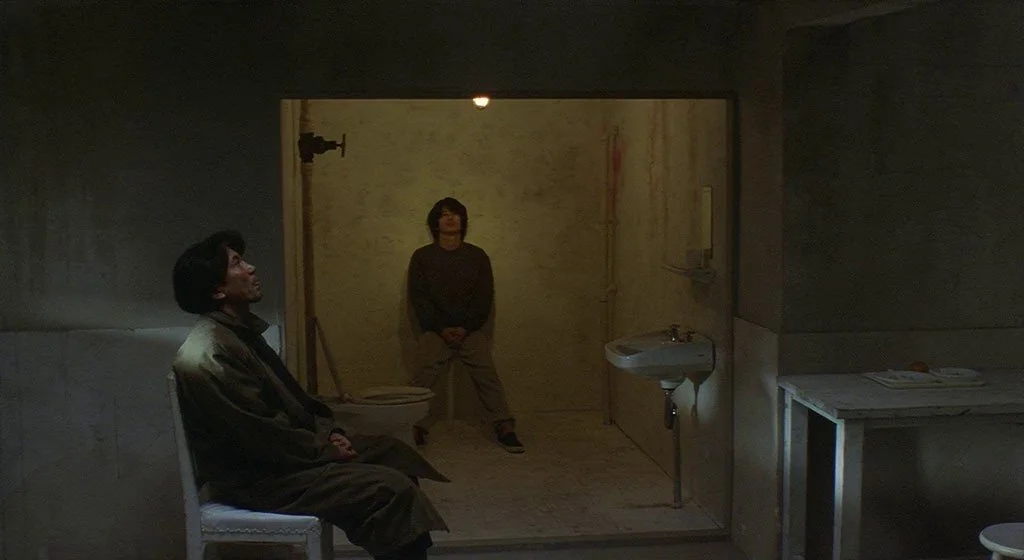"Cure" (1997) Review
Who are you?
How do you answer that question? Do you define yourself by your job? Do you define yourself in relationship to your romantic partners? Or maybe you define yourself by the art you make? Or do you define yourself by your ideology and its mission?
It’s a difficult question to answer, and trying to answer it is the beginning of a deeper horror in Cure, the horror that all of the ways we try to define ourselves lead to the most terrifying answer of all: That who we are is nothing real.
Cure is a difficult film to define. For roughly half of its runtime, it feels like Silence of the Lambs or Se7en, but from the very first scene there’s a deep strangeness to Cure that separates it from those films. As things progress though, Cure can’t be compared to much but itself and the work of its director, Kiyoshi Kurosawa, famous for imbuing his films with unbearable levels of dread.
The setup for Cure’s plot sounds like a standard serial killer crime drama at first. Detective Takabe (Kôji Yakusho) is investigating a series of murders where the victims have an X carved into their necks. Sounds simple, except that the murders have all been committed by completely separate people who are found near the crime scene with no memory or understanding of why they killed anyone. None of the killers have a history of mental illness, none of them are criminals. They are doctors, police officers, school teachers, all seen as the types who would never commit any serious crime let alone gruesome mutilations.
As Detective Takabe consults with psychologist Makoto Sakuma (Tsuyoshi Ujiki) about what could possibly be causing these murders, a strange amnesiac possibly named Mamiya (Masato Hagiwara) emerges, and seems to have a terrifying ability to influence individuals. Detective Takabe struggles to deal with Mamiya’s mind games while trying to take care of his mentally ill wife Fumie (Anna Nakagawa), forcing him to the edge of his sanity.
There are no words I can type that would possibly convey the deep dread that Cure will plant into your soul. The film is deeply uncanny to look at, seeming to take place in relatively normal locations where evil has entrenched itself. Shots as simple as a man standing off in the distance on an empty beach feel as disturbing as watching a man beat a woman with a lead pipe. And even when you watch a man kill a woman with a lead pipe, there are no quick cuts and close-ups. It happens in a fairly benign wide shot, quickly and bluntly.
The subtle uses of lighting and shadow are flawless in their execution. In a lot of horror-adjacent films, daylight can be a respite, but in Cure the moment in the film that makes my heart beat the fastest happens during the day when a man walks into an apartment’s bathroom. It’s not the nicest bathroom mind you, but what image appears in it is one of the most viscerally dread-inducing images I’ve ever laid eyes on that doesn’t have any blood in it. If I told you what it was, you probably wouldn’t think it was a big deal, but in context, it’s terrifying.
The quality of the actors across the board matches the quality of the filmmaking. Kôji Yakusho’s performance as Detective Takabe is amazing and intense, but the undisputed standout is Masato Hagiwara as Mamiya. When I made the comparison to Silence of the Lambs and Se7en, Masato Hagiwara is one of the reasons why. If you’re making a film like that, you need an Anthony Hopkins. You need a performer who will not only frighten but will transfix whoever watches the film. Masato Hagiwara’s performance is incredibly unique, straddling a terrifying line between a man who doesn’t know what’s going on to something like an entity seeking an even more sinister purpose than murder. Most importantly, the performance pulls you in, which is literally a key part of his entire character.
There’s not a ton to say about music in this film, there’s not a whole lot of it in there in the traditional sense. Most of the soundtrack is just droning creepy industrial noises, but that’s far from a complaint. They underline the dread-inducing scenes, and when combined with the film’s exceptional sound design, it only makes the imagery that much more frightening.
It feels as if Kiyoshi Kurosawa created this movie in a lab to strike at some of our most personal fears, but the creativity on display in the film’s story (especially in the back half of the film) is anything but procedural or made by formula. The entire film from start to finish is an unraveling of human identity, an unraveling that cannot be defined by sanity or insanity. It’s about the destruction of the ways we describe ourselves, and how those things may be masks for what all really are.
I will not say more about Cure. It is a deeply disturbing film, and one of the best movies of its kind. The kind it belongs to is itself, and nothing else. Any comparisons you can make to Cure are surface-level at best, and I deeply admire the fearless way it carves out a place for itself. I feel truly blessed to have had the opportunity to see this in a theater, and to be haunted by it for the rest of my days.



